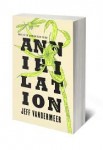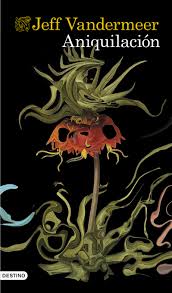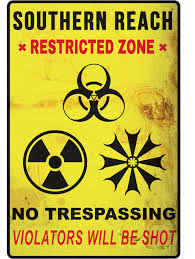 Annihilation, the first book of the Southern Reach trilogy and Jeff VanderMeer’s first novel in four years, is in barnstorming mode to say the least. You can purchase it here (you know you want to).
Annihilation, the first book of the Southern Reach trilogy and Jeff VanderMeer’s first novel in four years, is in barnstorming mode to say the least. You can purchase it here (you know you want to).
The story so far:
Annihilation is set in a remote coastal place called Area X, which has been separated from the rest of the world for thirty years by an invisible border. For thirty years, too, the secret government agency The Southern Reach has been sending in expeditions—usually with strange and disastrous results. The abandoned lighthouse, a tunnel spiraling into the ground, and something moaning off in the reeds are just the beginning of the mysteries faced by anyone who goes there. Annihilation recounts the discoveries made by the twelfth expedition, as chronicled by the reticent biologist attached to the mission. 
The novel’s been receiving rave reviews wherever it goes, including three starred reviews from library journals. The movie rights have been optioned. Foreign rights have been taken by twelve countries. These are all Good Things.
In the middle of his book tour, Jeff was kind enough to answer some questions for me.
1. So first things first: how did the Southern Reach trilogy come about?
I’ve said elsewhere it came to me in a dream—about descending into a subterranean tower with living words on the wall and some *thing* down below writing them. But I realize when I say this it makes it sound as if I simply recorded a dream and voila!—novel! In fact, stories from dreams are in some ways like any other inspiration for story: you have that one catalyst and then your brain wants to know what the story is around the catalyst. So I dreamed a dream and then found a story. Although I will say, sometimes while writing these novels, I felt as if things were looking out at me from the text, which is a strange and unsettling feeling.
2. All of your main protagonists in Annihilation are female – what was behind that choice?
It just was there, from the beginning, and I wasn’t sure if I’d stick with it or not, depending on how the characters worked out, but I very quickly could see all of their character arcs across the three books and then they were locked in place. And then I liked the idea of just offering up an all-female expedition without real comment, since often enough we get all-male expeditions without comment.
 3. How do you think this new trilogy shows how you’ve progressed as a writer over the past twenty-off years?
3. How do you think this new trilogy shows how you’ve progressed as a writer over the past twenty-off years?
I published my first story when I was 14, about 30 years ago, and made my first pro sale about 25 years ago. So, yes, I am ancient of days. I am a scarred leviathan-curmudgeon-writer thing. One of the main differences with the prior novels is that this time I’m writing about the real world, or some version of the real world. Relaxing into a setting that I was completely familiar with from my hiking meant the story unfolded at a pace and with an emphasis that diverges from prior work. I’m also less interested in self-conscious writing and visible experimentation, I think. In other ways, I’m up to my old tricks: the three novels of the series are told in very different ways. And then, because I try not to write the same novel twice—fungal references notwithstanding (squid!)—it often feels like I’m starting over from scratch. However, perhaps the real difference, which becomes more obvious in books two and three, is that I’m following the same characters from different angles in more complex ways than before.
4. How was it working with FSG?
Gorgeous. Beautiful. Satisfying. Comfortable. Safe. Daring. I still think a celestial choir started playing when I read the offer letter. The vision of what to do with the books was simple but daring. The pub schedule, everything. And they’ve been wonderful ever since.
5. Annihilation is written with no personal names – what kind of a challenge was it to write that way? 
Not much of one, to be honest. The characters are defined by what they do and what they say and, in the biologist’s case, what they think. Not having names just brings that to the fore—and forced me to review my decisions in differentiating the character’s behavior and hone that—even as it’s revealed it’s for practical reasons regarding the expeditions, too. I also don’t use any physical descriptions of the characters, and that was in part to make the landscape seem to encroach on them, and also because I’m sick to death of crappy descriptions of women by male writers in fiction. It’s not that I necessarily thought I’d be crap at it as that I thought it was irrelevant to them as people, so who cares what they look like? This also creates some interesting effects when you do learn more about them in book two—the assumptions readers may have made.
6. How did you feel when you heard the movie rights had been taken up?
The biggest sense of relief in the world. For a full-time writer money is time to breathe. I have worked at a killing pace for several years and so it wasn’t just elation but also complete and utter relief that I wasn’t going to have to worry about pushing myself to burn out for a while to come. I have to admit, after working on The Weird anthology and some other projects I began to have some worries that I was about to cross some kind of personal border from which I might not recover.
7. Wonderbook is going great guns. I understand it was a behemoth to “build” – will you ever take on a project like that again?
I always say I won’t, but then I dive in again. I suspect that I will, once I’ve had some time to recover from writing the Southern Reach. To be a little serious for a moment, the way I see it, we only have this one life, and this one brief moment to express what makes us happy. And writing books and editing books makes me happy, and I’m really best suited for that and nothing else. Part of doing that is taking chances. I told myself a long time ago that I would never not take on a project because of fear of failure or the unknown. So like some kind of unrepentant dumb-ass, I keep jumping into the void and trust that even if I don’t float like a feather I won’t plummet like a stone.
 8. What’s it like living with an editor? Not to mention one of the best editors around. Is Ann your first reader and critic? How many fights are there about comma placement?
8. What’s it like living with an editor? Not to mention one of the best editors around. Is Ann your first reader and critic? How many fights are there about comma placement?
Heh. Ann does do line-edits, but she’s a magnificent big-picture editor. So there aren’t any comma placement fights. But we do talk back and forth about my writing, and also about fiction and books and book culture in general, and that way help give each other perspective. Mostly, she will point out character motivations that feel forced, or a scene that isn’t working—that kind of thing—and then we will talk through why it isn’t working. She is my first reader. She’s also my best friend and confidante, and very funny.
9. How did it feel to hear that your backlist is being re-released by Macmillan UK , especially the wondrous City of Saints and Madmen? 
It was extremely unexpected. I didn’t realize that would be one consequence of having the new novels out. A definite bonus. I’m just thankful that those books will now reach a new generation of readers.
10. You’re an author who always seems to be involved in the aesthetics of your books and the cover art for the various editions of Annihilation is amazing – did you have any input into that, or has it been a matter of sitting back and watching the awesome roll in?
It’s been wonderful to just, as you put it, watch the awesome roll in without having to fret over the covers. I think these are some of the strongest covers I’ve ever had, and I want to own the original art on all of them. But, yes, this is the first time I’ve not been involved, although FSG has been kind enough to ask for my input.



4 Responses to Area X Marks the Spot: Welcome to the Southern Reach